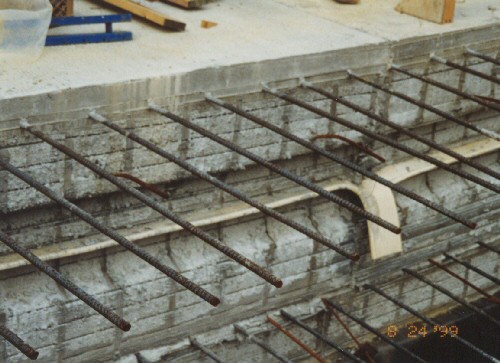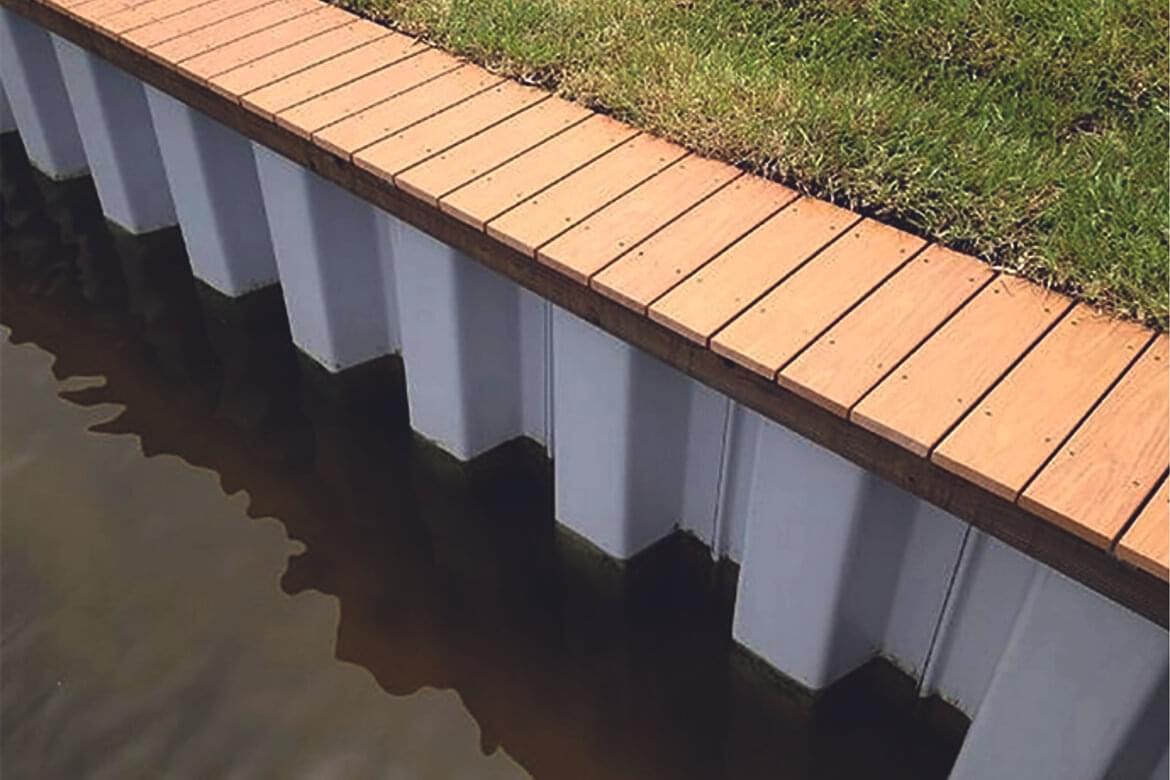Exploring the Different Usages of Bulkhead Frameworks in Modern Design
Bulkhead structures play a significant duty in modern architecture, offering both visual and functional objectives. They can specify areas, improve storage space options, and enhance lighting. In business setups, they act as focal factors that mirror brand name identity - Bulkhead on Lake Livingston. Furthermore, their combination usually supports sound administration and sustainable methods. Understanding the full scope of their applications discloses much about modern design fads and customer experience. What cutting-edge uses bulkheads might arise in the future?
Defining Bulkhead Frameworks
Bulkhead structures play a critical duty in contemporary design, acting as important components in different building styles. These structures are generally specified as elevated platforms or ceilings, usually made use of to conceal mechanical systems, electrical wiring, or pipes. Bulkheads can be found in both industrial and property setups, where they provide a smooth mix of performance and looks. Their design can integrate lighting components and other decorative components, improving the total visual allure of an area.
Generally built from products such as wood, drywall, or steel, bulkheads can be personalized to fit the building style and requirements of the building (Bulkhead on Lake Livingston). They offer not only to hide undesirable facilities but additionally to develop defined zones within open spaces. By handling the circulation of an area, bulkheads add to the spatial company, making them a substantial facet of modern building technique. Consequently, their definition encapsulates both practical and visual dimensions
Practical Applications in Residential Design
Bulkhead frameworks play a crucial duty in domestic design by helping with area optimization strategies that maximize usable locations. Additionally, they add visual style aspects that enhance the aesthetic appeal of living areas. In enhancement, these frameworks offer crucial structural assistance solutions, ensuring the integrity and safety and security of the home.
Area Optimization Strategies
As modern domestic designs progressively prioritize effective use area, ingenious approaches arise to take full advantage of capability without sacrificing aesthetic appeals. One popular method entails the integration of bulkhead frameworks, which can define areas while giving essential storage space services. These structures can be used to create upright storage units that improve both organization and availability. Additionally, multi-functional furniture, such as foldable tables and exchangeable couches, matches bulkhead styles, allowing areas to adapt to differing requirements. Open up flooring plans even more optimize spatial circulation, urging flexibility in operation. Including built-in shelving and recessed lighting within bulkheads likewise adds to a streamlined setting, ensuring that fully of space is utilized efficiently and harmoniously within the overall design.
Aesthetic Layout Aspects

Architectural Assistance Solutions
In modern domestic layout, an effective structural assistance service is important for maintaining the honesty of rooms while enhancing design and capability. Bulkhead structures play a significant duty in this scenario, offering as both support and partitioning aspects. They can hide mechanical systems, such as pipes and electrical circuitry, while offering reinforcement to the ceiling and floor systems. By purposefully putting bulkheads, designers can produce specified areas within open layout, improving functionality without compromising structural stability. Additionally, these frameworks can accommodate illumination fixtures, adding to both appearances and practicality. To summarize, bulkhead frameworks are vital in domestic style, offering flexible assistance remedies that enhance both the performance and aesthetic allure of living spaces.
Enhancing Appearances in Industrial Rooms
When industrial rooms embrace innovative bulkhead frameworks, they not only specify physical borders however additionally considerably enhance the overall visual appeals of the setting. These architectural aspects work as aesthetic centerpieces, drawing focus and creating a sense of intrigue. By integrating diverse products such as glass, steel, or timber, bulkheads can mirror a brand's identity and mission, adding to a natural layout.
The strategic positioning of bulkheads can adjust light and shadow, adding deepness and measurement to or else flat spaces. This interaction can transform a commercial location into an inviting ambience, motivating consumer engagement. Furthermore, making use of color and structure in bulkhead style can evoke certain feelings, boosting the general client experience. Eventually, the thoughtful combination of bulkhead frameworks elevates the visual charm of industrial spaces, making them not only useful but additionally aesthetically charming, therefore promoting an enduring impression on visitors.
Acoustic Performance and Audio Monitoring
Effective acoustic performance plays an essential duty in contemporary style, particularly within commercial rooms where audio monitoring is critical. Bulkhead structures can considerably enhance acoustic high qualities by soaking up noise, minimizing reverberation, and mitigating noise transfer between areas. These functions are particularly beneficial in environments such as cinemas, workplaces, and dining establishments, where clear communication and a positive acoustic experience are vital.
The calculated placement and style of bulkheads can help create sound-buffer areas, efficiently isolating noisy locations from quieter ones. Products made use of in bulkhead building, such as acoustic panels and soft surfaces, add to their sound-dampening capacities. Furthermore, the consolidation of bulkheads enables the combination of sound-absorbing components without endangering visual charm. By attending to acoustic efficiency, designers can develop harmonious settings that boost comfort, improve user experience, and promote performance, making bulkheads an essential element in the style of modern commercial spaces.
Integrating Bulkheads for Efficient Room Usage
Commonly ignored, the assimilation of bulkheads in building design can substantially enhance room usage in modern-day structures. These structural aspects offer multiple functional objectives, providing a way to hide mechanical systems, electrical wiring, and pipes without compromising aesthetics. By strategically placing bulkheads, designers can create specified locations within open flooring strategies, thus facilitating better organization and circulation.
Additionally, bulkheads can include storage options and lighting features, maximizing the performance of or else wasted vertical space. In household setups, they might delineate zones such as kitchens or living locations, while in commercial spaces, they can boost the performance of layouts by plainly marking paths and work areas.
Inevitably, the thoughtful integration of bulkheads adds to a much more visually enticing and well organized environment, enabling adaptable spaces that can evolve with the needs of their residents. This method not just enhances space but likewise cultivates a much more harmonious communication between type and feature.
Bulkheads in Public Design

Architectural Visual Enhancements
While several building aspects go for performance, bulkheads in public architecture offer a twin purpose by enhancing visual charm. These frameworks commonly develop visual rate of interest via their layout, incorporating seamlessly with surrounding aspects. By utilizing different materials, structures, and colors, bulkheads can contribute to a special identity for public areas, such as flight terminals, galleries, and collections. Their her explanation strategic positioning helps to define areas, directing site visitors while including depth to the overall layout. Furthermore, bulkheads can highlight lights, developing dynamic atmospheres that change throughout the day. This visual enhancement not just boosts the site visitor experience however additionally cultivates a feeling of place, making bulkheads a crucial consideration in contemporary public style. In general, bulkheads personify the blend of form and feature.

Architectural Support Solutions
As engineers look for ingenious methods to boost the structural stability of public spaces, bulkheads become essential parts in the layout and building and construction process. These frameworks offer crucial assistance, specifically in locations subject to heavy foot web traffic or vibrant loads. By dispersing weight equally, bulkheads aid avoid structural failure while permitting for functional design alternatives. In large places, such as stadiums and convention centers, bulkheads are usually integrated into the overall architectural framework, making certain stability and safety. In addition, they can assist in the consolidation of utilities and mechanical systems, adding to the effectiveness of room use. Ultimately, bulkheads stand for an important remedy in modern-day public style, enhancing both capability and safety and security in community-focused settings.
Environmental Defense Measures
Incorporating environmental management measures into public architecture has actually become progressively important as urban designers focus on sustainability alongside structural support. Bulkhead frameworks serve a dual objective in this regard, working as obstacles versus erosion and flooding while simultaneously improving the aesthetic charm of city landscapes. Their style typically consists of natural environments such as plant life, which can boost air high quality and give habitats for wild animals. Additionally, bulkheads can be crafted with absorptive materials that permit water absorption, minimizing drainage and advertising groundwater recharge. This assimilation of environmental considerations not just maintains the atmosphere however also fosters community durability against climate modification. By making use of bulkheads efficiently, architects add to sustainable city advancement that aligns with contemporary ecological objectives.
Future Fads in Bulkhead Layout
Emerging trends in bulkhead layout show a growing emphasis on sustainability, innovation, and functionality in contemporary style. Designers are increasingly integrating environment-friendly materials, such as recycled composites and bioplastics, to reduce environmental influence. In enhancement, the integration of wise innovation is becoming prevalent, allowing bulkheads to serve multi-functional functions, consisting of power storage space and environment control.
In metropolitan setups, modular bulkhead systems are obtaining traction, offering flexibility in style and convenience of setup. These systems can be adjusted to various landscapes, allowing for efficient area use. Furthermore, visual factors to consider are evolving; bulkheads are now being created to boost aesthetic allure, usually integrating artistic components that resonate with neighborhood culture.
As climate resilience becomes a top priority, future bulkhead styles will likely prioritize flooding defense and stormwater management, making certain architectural honesty while attending to ecological obstacles. This change signifies a holistic technique to architecture that fulfills both environmental duties and human requirements.
Frequently Asked Concerns
What Materials Are Commonly Made Use Of for Bulkhead Construction?
Common products for bulkhead construction include concrete, steel, lumber, and composite products. These alternatives supply toughness, structural integrity, and resistance to environmental variables, making them appropriate for various applications in building and design projects.
How Do Bulkheads Influence Building Power Performance?
Bulkheads enhance developing energy effectiveness by providing thermal insulation and reducing air leakage (Bulkhead on Lake Livingston). They assist keep indoor temperature levels, consequently lowering home heating and cooling needs, ultimately resulting in reduced energy prices and improved ecological sustainability
Are There Any Building Regulations Details to Bulkhead Structures?
Yes, building codes particular to bulkhead structures exist, differing by location. These guidelines normally deal with safety, architectural integrity, and accessibility, guaranteeing that bulkheads about his satisfy called for criteria for building and construction and design within a given territory.
Can Bulkheads Be Easily Changed or Gotten Rid Of Later?
Bulkheads can usually be modified or gotten rid of, relying on their design and building. Such changes may require cautious preparation and adherence to building codes to ensure architectural stability and safety and security are preserved throughout the process.
What Are the Costs Associated With Mounting Bulkhead Structures?
The costs related to installing bulkhead frameworks can differ significantly, usually influenced by products, style complexity, and labor. Typically, costs range from modest to high, depending on the job's particular demands website link and area.
Bulkhead frameworks play a critical function in modern-day style, serving as necessary parts in numerous building styles. Bulkhead structures play an important duty in property design by helping with room optimization strategies that take full advantage of useful locations. Typically forgotten, the combination of bulkheads in building layout can substantially improve area use in modern buildings. As designers seek innovative methods to improve the architectural integrity of public rooms, bulkheads arise as important components in the layout and construction process. The costs connected with installing bulkhead structures can differ significantly, typically influenced by products, layout complexity, and labor.